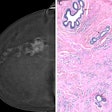Wednesday, November 29 | 11:30 a.m.-11:40 a.m. | SSK02-07 | Room E451A
Using automated measurements of breast parenchymal patterns derived from synthesized digital breast tomosynthesis exams could help assess cancer risk, according to researchers from the University of Pennsylvania.Synthetic 2D mammograms are increasingly being used to reduce the radiation dose during screening with digital breast tomosynthesis; as a result, standard-dose mammograms to evaluate breast parenchymal patterns may no longer be acquired.
This study shows that "breast parenchymal pattern measurements extracted from synthetic digital mammograms are different yet correlated with those made from standard-dose digital mammograms," said postdoctoral fellow Aimilia Gastounioti, PhD. "The findings pave the way for extending widely used mammographic measures for synthetic digital mammograms and provide preliminary evidence about subsequent implications in related interpretation."
Gastounioti and colleagues retrospectively analyzed more than 7,300 pairs of bilateral 2D mammograms and synthetic C-view images corresponding to approximately 3,700 women with negative (BI-RADS 1 or 2) routine screening evaluation. Both 2D mammograms and synthesized 2D mammograms were available for each screening exam (Selenia Dimensions, Hologic) over a four-month period. For each image, estimations were made for 26 established parenchymal pattern descriptors, which included gray-level histogram and fractal dimension texture features.
Most features were strongly or moderately correlated between the 2D mammograms and synthesized 2D mammograms, the researchers found. However, all measurements differed significantly between the two mammographic types.
Regardless of the type, parenchymal texture measures demonstrated weak to moderate correlations with breast percent density and strong bilateral symmetry, with significantly increased intraclass correlation coefficient values for synthesized 2D mammograms.
"The rapid implementation of synthetic digital mammography necessitates robust measures to characterize the breast parenchymal pattern from synthetic images," Gastounioti told AuntMinnie.com. "Therefore, our study could accelerate the integration of quantitative imaging phenotypes for breast cancer risk assessment in clinical settings where it is very likely that standard-dose digital mammograms will soon be fully replaced by synthetic mammograms."



















